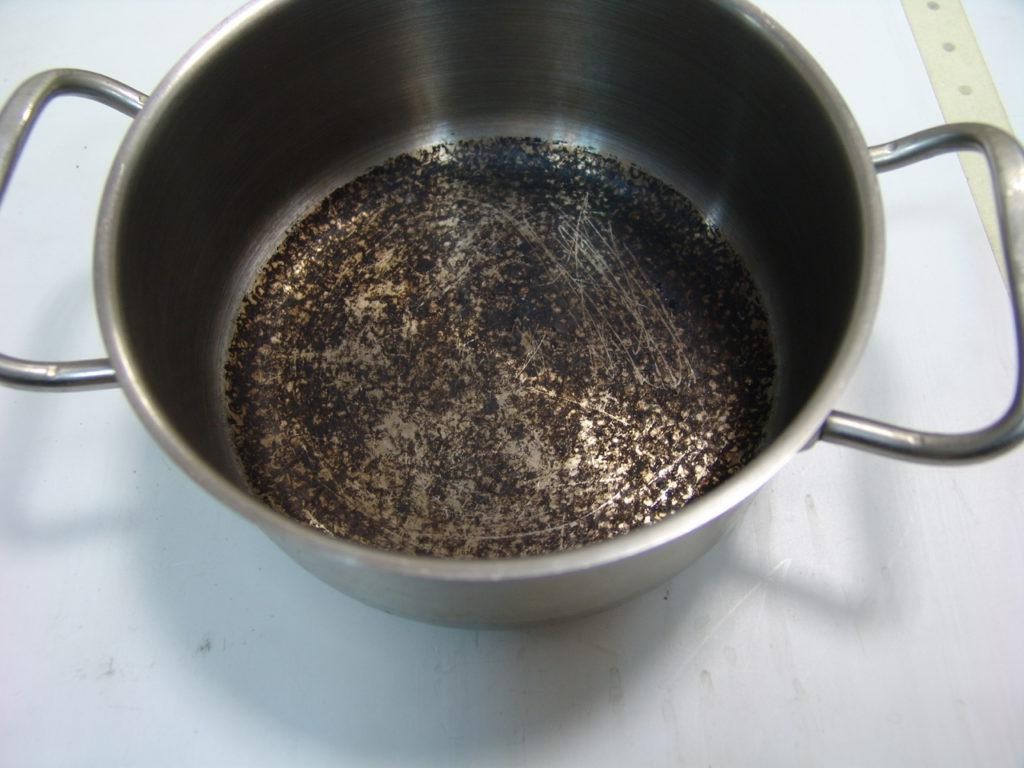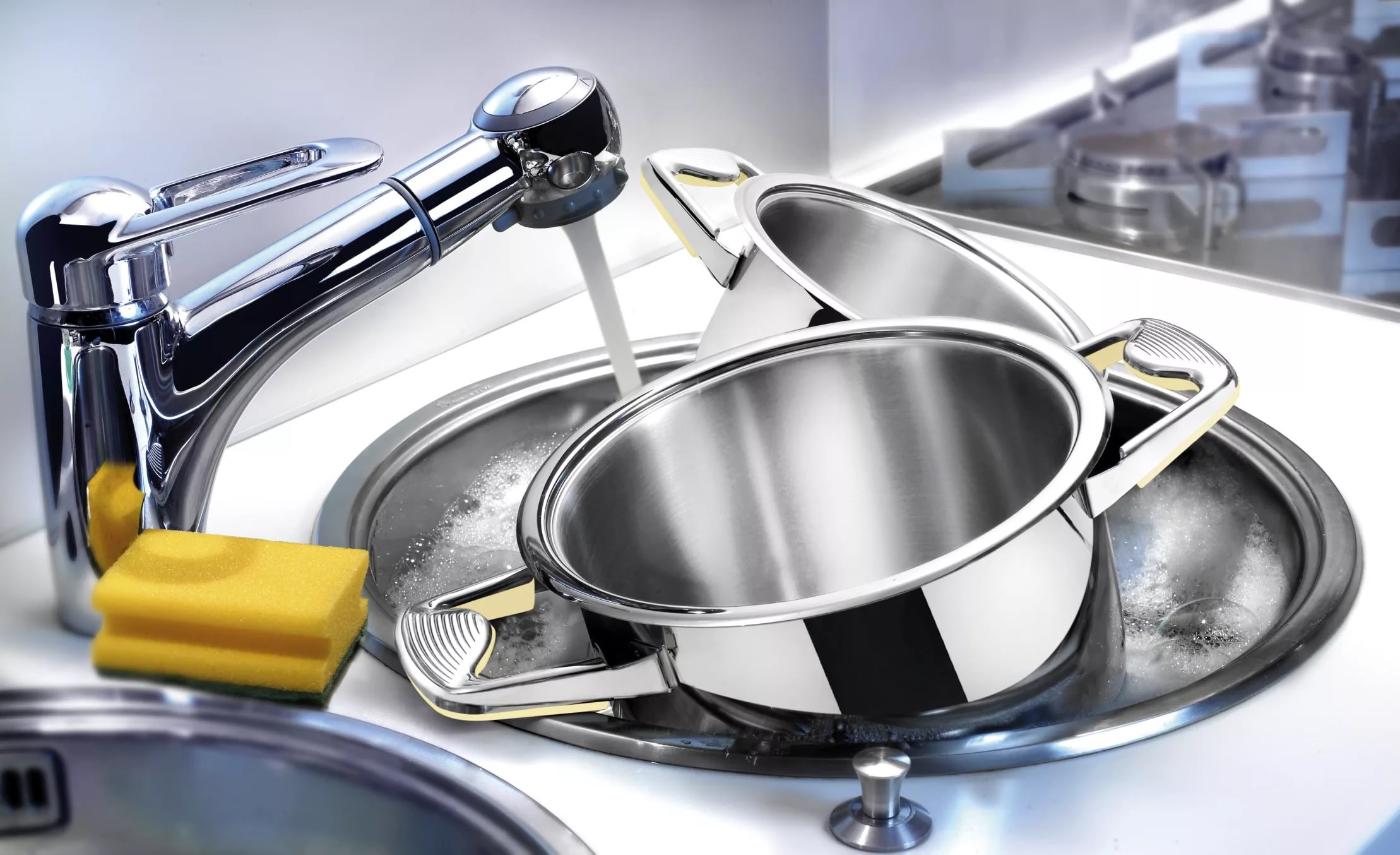How to clean a burnt pot
Only the housewives from the TV do all the kitchen utensils shine with a mirror shine. In many real kitchens, you will definitely find dishes with traces of carbon deposits on the bottom, or even on the walls. How can I clean a burnt pot or skillet safely and effortlessly?

Causes of food burning
Why do porridge, jam and other food burn at all? Why do enamel, stainless steel, aluminum, cast iron and even non-stick coating burn?

There are five reasons:
- Low quality cookware coating. Even branded non-stick products are short-lived - they last for a maximum of 3 years, and the age of counterfeiting is even shorter. In our age of cheap "disposable" things, unscrupulous manufacturers even allow themselves to enamel pots with violations of technology in order to reduce the cost of production.
- Natural wear of the coating. Only cast iron can serve for decades.
- Mechanical damage that has arisen on the coating during use and from improper handling - there are frequent scratches on aluminum, microcracks on ceramics and Teflon, enamel is susceptible to chips and corrosion.
- Inattention of the owners - often the dishes burn on too high a heat or when the owners are distracted by something from the cooking process.
- Careless washing - a layer of fat that remains on the coating after poor-quality washing readily mixes with soot, forming a base for carbon deposits. Such dishes will burn more often and faster.

What to do if a saucepan is burnt
It is often possible to understand that food has burned out or is just starting to burn by the characteristic smell of a spoiled dish. It is necessary to remove the pan or other damaged dishes from the fire, transfer the surviving food from it and assess the degree of damage.

Often you have to wait until the pot or pan cools down and wash it. The dirt left after washing on the bottom and walls is carbon deposits. Depending on the severity of the case, you should choose methods and means for cleaning it.

Severe burns
Heavy soot is a layer of burnt food on the bottom and walls of the dishes with a thickness of more than 1-2 mm. It is usually charcoal black in color with a soft surface. But the deeper layers seem to be firmly "adhered" to the coating.

The way to clean the product effectively:
- Clean off the soft top layer of carbon with metal dishwashers, without touching the coating.
- Pour 9% table vinegar over the bottom, firmly adhering layer so that it is covered all over. Wait 15-20 minutes for the vinegar to soften the burn.
- Drain it, pour cold water just above the burn-in level.
- Add a tablespoon or two of citric acid.
- Put the container on fire, boil water, reduce heat and simmer until the burn begins to recede.

Important! If the first attempt is ineffective, you can repeat the procedure with citric acid as many times as you like until all the carbon deposits are gone. This is a completely harmless remedy.

Moderate burn
This is a less severe case - the burn is clearly visible, but its layer is not so thick. Activated carbon is suitable for cleaning such contaminants - this is a budgetary, but effective tool. One package is often sufficient.

The tablets must be finely crushed and all burned areas covered with the resulting black powder. Close the container with a lid, wait about 20 minutes. The fine powdery fraction will absorb impurities. Then pour warm water into the container so that it covers the burn, and wait another half hour. Pour out water and remove dirt with a sponge and any kind of dish detergent.

Light burns
The most popular homemade way to clean up light coke is with your familiar baking soda. She needs to cover the darkened areas, wait a few minutes and rub them with a sponge.

Important! Boiling milk and cooking meat dishes are usually carefully monitored, but if they happen to burn slightly, it is soda that is ideal for removing burnt from protein products.
Traditional methods of cleaning dishes
How to use home remedies to clean the burnt bottom of the pan? In addition to the already mentioned soda, citric acid and activated carbon, you can do this using various means.

Glue
For the simplest method, you will need 150 g of PVA, a grated piece of laundry soap and a container where the dishes that need cleaning will fit. Fill the container with water, mix the ingredients in it, bring to a boil and put the burnt dishes there. After boiling water again, reduce heat and "cook" the dishes for 1-2 hours. Then wash off the burn - it will wash off easily.

But the product is not recommended for aluminum and Teflon (will darken).

Plastic and wooden parts, if any, should be removed before boiling. And after processing, if it is a frying pan, grease its walls and bottom with vegetable oil and ignite in the oven for half an hour to restore the natural non-stick layer.
Acetic acid
For best action, it should be poured into a burnt container and brought to a boil on the stove, then let the solution stand for an hour or two.

A mixture of salt and vinegar
A solution of 2-3 tablespoons of salt, water and 150 ml of vinegar is prepared, then wait for the burn to soften.

Blends of soda and hydrogen peroxide
Half a pack of soda filled with peroxide (it will take a lot, but today they are no longer selling tiny bubbles) makes an excellent cleansing mixture.

Important! Often, after washing the dishes with fairly delicate home remedies, the surface is clean of carbon deposits, but the dishes emit a persistent unpleasant smell of burnt food.
How to get rid of it? There is a simple way: "tightly" cover a foul-smelling container with a wet dense material with good absorbent properties - for example, a towel. After 10-15 minutes, the fabric will absorb unappetizing aromas.
Chemicals for removing carbon deposits
How to chemically clean the pan from carbon deposits? Let the owners not be confused by the inscription on the label: "For ovens", these products are also great for dishes. Branded grease removers have proven themselves excellent:
- Shumanit, Giant - Israeli brand Bagi;
- Mister Chister is a domestic brand;
- Oven Cleaner - Amway products;
- Sparkling Kazan - NBT-Siberia company.
How to use them to wash carbon deposits from a saucepan or frying pan:
- Treat burnt areas inside and outside of the cookware with the agent.
- A tip for getting rid of pungent chemical odors is to put the dishes in a plastic bag or wrap them in plastic wrap after applying the product.
- Leave the product on the surface for 10 to 40 minutes (following the instructions).
- Wash the dishes in the usual way, rinse thoroughly, preferably more than once.

Important! If children and pets live in the house, it is recommended to use Oven Cleaner - the product does not emit a deadly odor, is economical in consumption, and acts extremely effectively.
But you can buy it in the company's online store or from dealers, and the cost of the tool is quite high.
Cleaning Precautions
If you are going to clean the dishes from carbon deposits using chemicals, you should:
- protect the skin and respiratory tract - wear gloves and a mask;
- open windows and, if possible, doors to thoroughly ventilate the room;
- eliminate children, the elderly, and pets from the kitchen in order to avoid allergic reactions and intoxication;
- after cleaning, wash the work surfaces with soap and rinse.

Important! Shumanite works great, but is extremely caustic and toxic.
Non-stick cleaning features
There is one peculiarity here: the mechanical method of removing carbon deposits is strictly prohibited. It is unacceptable to scrape the affected surface with wire and metal brushes, and even more so with a knife. It is so easy to irreversibly damage not only Teflon and ceramics, but also deeply scratch aluminum, stainless steel and enamel coatings.

You need to be patient and clean the carbon deposits from pots and pans with gentle methods - folk or chemical means, waiting until the burnt layer reacts with the substances used and softens. Carbon deposits should be removed delicately - with a soft sponge or cloth.
Carbon deposits prevention
How can i avoid deposits on the dishes? Observe simple recommendations for its operation:
- Closely monitor the preparation of food, do not leave cooking dishes unattended, and regulate the heat under a saucepan or frying pan in time.
- Control the presence in the dish of the required amount of liquid (sauce, water), oil, fat.
- Do not use metal accessories that could scratch the sides and bottom of the dishes to stir and lay food. There are plastic and wooden spoons and spatulas that are safe to cover.
- Try to exclude washing with metal brushes and sponges.
- Do not store (even short-term) damp dishes - moisture is an excellent breeding ground for mold, and mold destroys the non-stick coating.
- Pans (especially) with teflon and ceramic coating should not be stored stacked one in the other - the upper one can damage the coating of the lower one.
- It is recommended to use apple cider vinegar to prevent aluminum pans or other pans made from porous metals from burning. It should be added when oil has already been poured into the bottom and warmed up. On low heat, the vinegar will quickly evaporate without affecting the taste of the future dish, but will help protect the metal surface from carbon deposits.
- Salt is used in a similar way - it is also poured into the bottom of the pan, already oiled or greased.Pour it in sparingly so that the dish does not turn out to be salty later. If you accidentally add too much salt, you can easily remove the excess with a napkin or kitchen paper towel.

Even the best housewife is not immune from burning food in a saucepan or frying pan - but many ways will help get rid of an ugly burn. And in order to avoid this fuss, it is recommended to use your "kitchen assistants" carefully and responsibly!
Video: how to clean a burnt pot or frying pan









